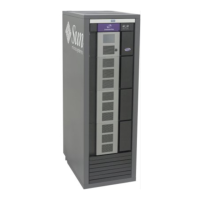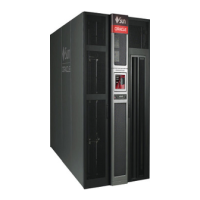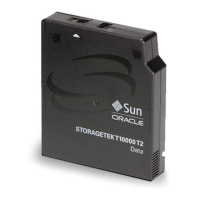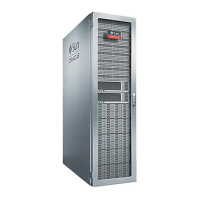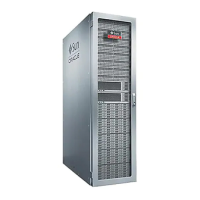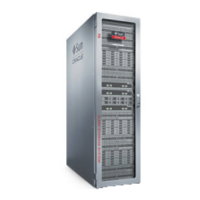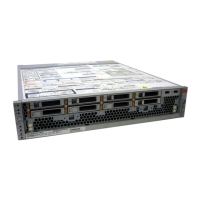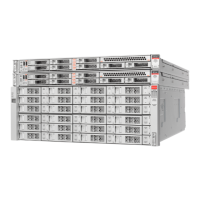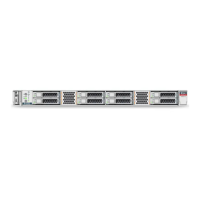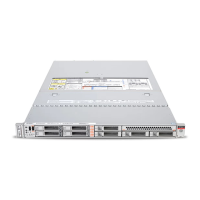Do you have a question about the Oracle storagetek sl150 and is the answer not in the manual?
Explains textual conventions used in the document.
Information about Oracle's accessibility program.
Details on how to obtain technical support from Oracle.
Introduces fundamental design and functionality concepts of the SL150 library.
Describes how the library operates automatically under host control.
Explains access control mechanisms and user roles for system security.
Details the view-only access permissions for Viewer role users.
Details the limited operational control permissions for Operator role users.
Details the permissions for Oracle service representatives.
Details the comprehensive control and configuration permissions for Administrator role users.
Explains the single, unified path for library communication and data transfer.
Describes how to divide the library for multiple host applications.
Introduction to the web-based interface for managing the library.
Information on the library's design for easy maintenance and CRU replacement.
Details the physical structure of base and expansion modules.
Describes the operator panel, LEDs, and power button on the front.
Details the network ports, power supplies, and drive access on the rear.
The primary web application for library management.
Options to adjust UI for screen readers, contrast, and font size.
Describes the dashboard, power, locator, and activity indicators.
Overview of different screens available in the user interface.
Summarizes library resources assigned to each configured partition.
Displays detailed properties and status of installed tape drives.
Displays detailed properties and status of tape cartridges.
For modifying network, library, and partition settings.
For viewing and managing library and drive firmware versions.
For configuring monitoring and notification settings.
For managing user accounts, roles, and passwords.
For reviewing product identification and health logs.
Step-by-step instructions for accessing the library's remote user interface.
Using the local panel for status checks and basic tasks.
Displays critical library health and connection status indicators.
The main navigation screen for the operator panel.
Describes the text-oriented information on the operator panel.
Instructions on how to navigate long displays on the operator panel.
Explains the necessity of a user account to access the library's interface.
Provides guidance on selecting a suitable web browser for the interface.
A specific troubleshooting step for Firefox browser security settings.
Step-by-step procedure for logging into the library's user interface.
Configuration options for screen readers, contrast, and font size.
Procedure for securely ending a user session.
Explains how to understand the visual elements of the library interface.
Describes methods for moving between different screens and elements in the UI.
Details standard controls for data tables within the UI.
Control to change how data is displayed in tables.
Dialog to customize displayed columns in data tables.
Dialog to change the order of columns in data tables.
Function to download data tables from the interface.
Function to print data tables from the interface.
Accessing user-specific settings within the interface.
Procedure for changing the user's password.
Controls for managing automatic UI screen updates.
Steps to set up automatic or manual drive cleaning.
Procedures for physically loading cartridges into magazines.
Performing self-tests to verify the library's installation.
Choosing the method for cleaning tape drives.
Enabling the library's built-in automatic drive cleaning.
Using host applications to manage drive cleaning.
Setting up Oracle Secure Backup for automatic drive cleaning.
Configuring NetBackup via its console for reactive cleaning.
Configuring NetBackup via the command line for reactive cleaning.
Configuring Symantec Backup Exec for drive cleaning.
Configuring HP Data Protector for drive cleaning.
Configuring IBM Tivoli Storage Manager for as-needed cleaning.
Configuring EMC Networker for tape alert cleaning.
Configuring CommVault for drive cleaning.
Strategy for performing manual drive cleaning.
Deciding how many system reserved slots are needed for media.
Guidance on preparing a clean area for handling cartridges.
Steps to create or prepare a diagnostic tape cartridge.
Determining the quantity of cleaning cartridges required for operation.
Procedures for preparing new cleaning tape cartridges.
Procedures for preparing new data tape cartridges.
Procedure to unlock magazines using the browser interface.
Steps for loading magazines into the library's base module.
Table illustrating reservable slots in the left magazine of module 1.
Table showing a diagnostic tape placed in a reserved slot.
Table showing a cleaning tape in a reserved slot.
Table showing diagnostic and cleaning tapes in reserved slots.
Table showing cleaning tapes in reserved slots.
Table showing cleaning tapes placed in regular storage slots.
Table illustrating filled reserved slots with diagnostic/cleaning tapes.
Table showing cleaning tapes in partition 1's right magazine.
Table showing cleaning tapes in partition 2's right magazine.
Table showing data tapes loaded into the right magazine.
Procedures for loading magazines into expansion modules.
Table showing data tapes in an expansion module's left magazine.
Table showing data tapes in an expansion module's right magazine.
Procedures for locking magazines and performing a library audit after loading media.
Detailed steps for running a library self-test.
Configuring core library parameters like time and network settings.
Procedures for managing library and drive firmware.
Steps to reset the library to its original factory default state.
Using the wizard to guide through configuration tasks.
Setting up the library's network ports and IP addressing.
Detailed steps for configuring the primary network interface.
Configuring dual-stack IP addressing for network port 1.
Configuring IPv4-only addressing for network port 1.
Managing access to the library's service network port.
Configuring the library's internal clock and time zone.
Selecting the correct time zone for the library.
Manually setting the library's date and time.
Synchronizing the library's clock with Network Time Protocol servers.
Adjusting various library operational settings.
Configuring how drives are addressed by the system.
Enabling the library's automatic drive cleaning feature.
Options for configuring the mailslot's size and behavior.
Configuring slots reserved for library use (e.g., cleaning media).
Enabling or disabling the library's partitioning feature.
Procedures for creating, deleting, and managing partitions.
Step-by-step guide to adding a new partition to the library.
Steps for removing an existing partition from the library.
Assigning drives and magazines to specific partitions.
Reviewing and committing configuration changes made via the wizard.
Verifying web browser compatibility with IPv6 addresses.
How to check the installed version of the library's firmware.
How to check the installed version of each drive's firmware.
Steps to search for and identify newer library firmware versions.
Procedures for downloading and verifying library firmware files.
Steps to search for and identify newer drive firmware versions.
Procedures for downloading and verifying drive firmware files.
Step-by-step guide to installing new library firmware.
Step-by-step guide to installing new drive firmware.
The interface panel used to initiate drive firmware upgrades.
Choosing the correct firmware file for the upgrade process.
Procedure to roll back the library firmware to an earlier version.
Additional tasks to integrate the library into the environment.
Detailed steps to perform a factory default reset of the library.
Steps to create new user accounts and assign them specific roles.
Procedure for deleting existing user accounts from the system.
How to modify the role assigned to a user account.
Procedure for administrators to reset user passwords.
Overview of compatible tape media types and generations.
Essential precautions for handling tape cartridges safely.
Guidelines and procedures for applying labels to cartridges.
Steps to inspect cartridges for defects before use.
Guidance on preparing diagnostic tape cartridges for testing.
Step-by-step instructions for applying labels to tape cartridges.
Detailed inspection checks for LTO cartridges to ensure proper condition.
Procedures for bulk loading and unloading tape cartridges using magazines.
Steps to unlock magazines via the browser-based user interface.
Procedures for loading and unloading individual cartridges into magazines.
Steps for properly reinstalling magazines into the library modules.
Locking magazines and performing a library audit after loading media.
Using the mailslot for importing or exporting cartridges.
Assigning the mailslot to a specific partition for media access control.
Assigning the mailslot via the browser-based user interface.
Assigning the mailslot via the local operator panel.
Steps for importing tape cartridges into the library using the mailslot.
Steps for exporting tape cartridges from the library using the mailslot.
Procedures to open the mailslot.
Opening the mailslot using the web interface.
Opening the mailslot using the local operator panel.
Procedure for closing the mailslot.
Removing the mailslot's assignment from a partition.
Unassigning the mailslot via the browser interface.
Unassigning the mailslot via the operator panel.
Moving tape cartridges using the library's user interface.
Steps for moving cartridges via the web interface.
Utilizing the library's interfaces for monitoring tasks.
Steps for diagnosing and resolving library issues.
Procedures for obtaining assistance, parts, and firmware updates.
Monitoring the library's status via the web interface.
Reviewing the library's health and connection status from the dashboard.
Viewing specific fault codes and suspect components for degraded or failed states.
Detailed status information for drives and tapes.
Lists and explains the columns for drive properties in the UI.
Lists and explains the columns for tape properties in the UI.
Status of tape media based on cartridge memory and alerts.
Checking library status and configuration using the physical operator panel.
Interpreting the status indicated by LEDs on the library and its components.
Configuring the library for monitoring via SNMP.
Activating SNMP support on the library.
Deactivating SNMP support on the library.
Creating user accounts for SNMP access.
Modifying parameters for existing SNMP users.
Removing SNMP user accounts.
Configuring network stations to receive SNMP traps.
Modifying settings for SNMP trap recipients.
Removing configured SNMP trap recipients.
Sending a test SNMP trap to verify configuration.
Obtaining the MIB file for SNMP management.
Enabling support for the Oracle SDP2 platform.
Disabling support for the Oracle SDP2 platform.
Setting up email alerts for library status changes.
Configuring the library to send emails via an SMTP server.
Managing the list of email addresses that receive alerts.
Adding new email addresses to receive alerts.
Modifying details for existing email alert recipients.
Sending a test email alert to verify configuration.
Removing email addresses from the alert recipient list.
Troubleshooting issues related to the browser interface.
Steps to diagnose and resolve browser-related problems.
Procedures for identifying and resolving library operational issues.
Analyzing the library's health table for fault records.
Investigating potential causes listed in fault records.
Steps for removing magazines when the library is inoperable or powered off.
Procedures to free a cartridge stuck within a magazine slot.
Procedures to free a cartridge stuck inside a tape drive.
Finding and removing physical obstructions within the library.
Reviewing the library's health log to track fault resolution.
Executing basic or full self-tests to check library functionality.
Exporting the library's health log for offline analysis or support.
Searching Oracle Support for solutions to issues.
Procedures for obtaining the latest firmware for the library and drives.
Detailed steps to download the latest library firmware.
Detailed steps to download the latest drive firmware.
How to open a service request with Oracle Support.
Procedures for safely taking the library offline and bringing it back online.
Steps for powering the library system on and off.
Routine maintenance tasks for tape drives.
Procedures for relocating the library to a new location.
Steps to bring the library offline for maintenance.
Steps to bring the library back online after maintenance.
Procedure to turn on the library's power.
Procedure to turn off the library's power.
Securing the robot mechanism before performing certain maintenance.
Releasing the robot lock after maintenance procedures are complete.
Procedures for restarting the library system.
How the library recovers and restarts after a power interruption.
The process of checking library contents and updating the media catalog.
Performing a manual audit of the library's contents.
Procedures for managing cleaning cartridges.
Steps for cleaning tape drives when necessary.
Procedures for restarting individual tape drives.
Steps to prepare a drive before removing it from the library.
Checking the status of cleaning cartridges via the library UI.
Replacing expired cleaning media using the host application interface.
Replacing expired cleaning media using the library's user interface.
Enabling the library's automatic drive cleaning feature.
Manual cleaning of drives using the library's user interface.
Identifying drives that require cleaning based on status indicators.
Step-by-step guide to cleaning a specific degraded drive via the UI.
Instructions for obtaining and installing updated drive firmware.
Procedure for safely moving the library to a new location.
Mapping physical cartridge labels to logical labels for host applications.
How the library handles cartridges with problematic or missing labels.
Positioning the robot in its housing before locking.
Securing the robot mechanism with the lock assembly.
Releasing the robot lock after maintenance procedures are complete.
